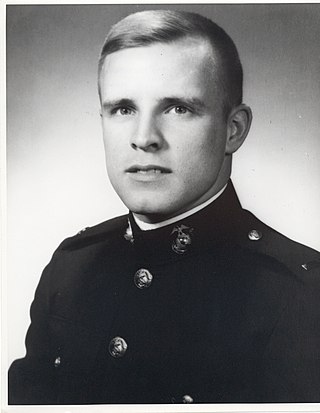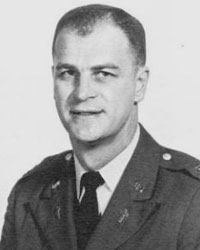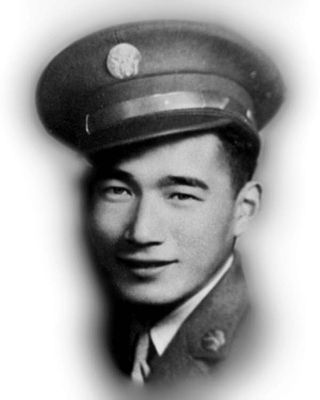
The 1st Cavalry Division is a combined arms division and is one of the most decorated combat divisions of the United States Army. It is based at Fort Cavazos, Texas. It was formed in 1921 and served during World War II, the Korean War, the Vietnam War, the Persian Gulf War, with the Stabilization Force in Bosnia-Herzegovina, in the Iraq War, in the War in Afghanistan as well as Operation Freedom's Sentinel and Operation Inherent Resolve. As of July 2023, the 1st Cavalry Division is subordinate to III Armored Corps and is commanded by Major General Kevin D. Admiral.

Gregory "Pappy" Boyington was an American combat pilot who was a United States Marine Corps fighter ace during World War II. He received the Medal of Honor and the Navy Cross. A Marine aviator with the Pacific fleet in 1941, Boyington joined the "Flying Tigers" of the Republic of China Air Force and saw combat in Burma in late 1941 and 1942 during the military conflict between China and Japan.

The Battle of Ia Drang was the first major battle between the United States Army and the People's Army of Vietnam (PAVN), as part of the Pleiku Campaign conducted early in the Vietnam War, at the eastern foot of the Chu Pong Massif in the central highlands of Vietnam, in 1965. It is notable for being the first large scale helicopter air assault and also the first use of Boeing B-52 Stratofortress strategic bombers in a tactical support role. Ia Drang set the blueprint for the Vietnam War with the Americans relying on air mobility, artillery fire and close air support, while the PAVN neutralized that firepower by quickly engaging American forces at very close range.

We Were Soldiers is a 2002 war film written and directed by Randall Wallace and starring Mel Gibson. Based on the book We Were Soldiers Once… and Young (1992) by Lieutenant General (Ret.) Hal Moore and reporter Joseph L. Galloway, it dramatizes the Battle of Ia Drang on November 14, 1965.

Terrence Collinson Graves was a United States Marine Corps officer who was posthumously awarded the Medal of Honor for his "outstanding courage, superb leadership and indomitable fighting spirit" on 16 February 1968, during the Vietnam War.

Charles James "Charlie" Liteky, formerly known as Angelo Liteky, was an American peace activist who served as a United States Army chaplain in the Vietnam War and was awarded the U.S. military's highest decoration, the Medal of Honor. A Roman Catholic priest, Liteky received the award for braving intense fire to carry 20 wounded soldiers to safety during a 1967 battle. He later left the priesthood, became a social activist, and in 1986 renounced his Medal of Honor.

Michael J. Novosel Sr. of Enterprise, Alabama served in the United States military during World War II, the Korean War, and the Vietnam War. He flew the B-29 Superfortress bomber in World War II. In order to serve in the Vietnam War, he gave up the rank of lieutenant colonel in the Air Force Reserve and became a chief warrant officer in the Army. He was awarded the Medal of Honor, the United States' highest military decoration, for his bravery in conducting a medical evacuation under fire in the Vietnam War. Fort Rucker, Alabama was renamed Fort Novosel in his honor in April 2023.

Colonel Archie Van Winkle was a United States Marine who was awarded the Medal of Honor for his actions as a staff sergeant during the advance to the Chosin Reservoir in the Korean War.

Patrick Henry Brady, is a retired United States Army major general. While serving as a helicopter pilot in the Vietnam War, he received the Medal of Honor, the nation's highest military decoration for valor.

Major Charles Livingston Kelly was a United States Army helicopter pilot and medical evacuation unit commander during the Vietnam War. Because of the central role he played in the development of early battlefield evacuation techniques during the war—and the central role his death on the battlefield played in cementing those techniques in Army doctrine at a time they were being questioned by line commanders—he earned the sobriquet "The Father of Dustoff".

Deming Bronson was a United States Army officer who received the United States military's highest award, the Medal of Honor, for his actions in World War I.

Ed W. "Too Tall" Freeman was a United States Army helicopter pilot who received the United States military's highest decoration, the Medal of Honor, for his actions in the Battle of Ia Drang during the Vietnam War. During the battle, he flew through machine gunfire 14 times, bringing supplies to a trapped American battalion and flying dozens of wounded soldiers to safety. Freeman was a wingman for Major Bruce Crandall who also received the Medal of Honor for the same missions.

William Edward Adams was a major in the United States Army who was posthumously awarded the Medal of Honor for his actions during the Vietnam War.

David Herbert McNerney was a United States Army soldier and a recipient of the United States military's highest decoration—the Medal of Honor—for his actions in the Vietnam War. A native of Massachusetts who moved to Houston, Texas, as a child, McNerney served in the U.S. Navy during the Korean War before enlisting in the Army. He was recognized with the Medal of Honor when, as a first sergeant in Vietnam on March 22, 1967, his company came under attack by a numerically superior North Vietnamese force. They nearly split the company and killed or wounded all of the officers. Although wounded, McNerney took command of the company and organized the unit's defense, exposing himself to hostile fire to mark and clear a helicopter landing site. He refused to be evacuated for an entire day until a new commander came. After serving four tours of duty in Vietnam and 16 years of service, McNerney retired in 1969 and began a career as a customs inspector in Houston.

Robert Ronald Leisy was a United States Army officer and a recipient of the United States military's highest decoration—the Medal of Honor—for his actions in the Vietnam War.

Frederick Edgar Ferguson is a former United States Army warrant officer and later officer, as well as a recipient of the United States military's highest decoration—the Medal of Honor—for his actions in the Vietnam War while a chief warrant officer 3.

John Druse "Bud" Hawk was a United States Army soldier and a recipient of the United States military's highest decoration, the Medal of Honor, for his actions in World War II during the battle of the Falaise pocket.

William Kenzo Nakamura was a United States Army soldier and a recipient of the United States military's highest decoration—the Medal of Honor—for his actions in World War II.

Charles Seymour Kettles was a United States Army lieutenant colonel and a Medal of Honor recipient.

Alan "Ace" Cozzalio was an American army officer, primarily known for his distinguished service as a helicopter pilot in the Vietnam War. Initially nominated for the Medal of Honor, he instead received the Distinguished Service Cross as well as every lesser commendation of valor. He remained in the army, rising to the rank of Lieutenant colonel before being medically retired due to heart problems. He died six years later at the age of 46 after an unsuccessful heart transplant operation.




























